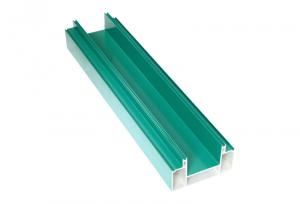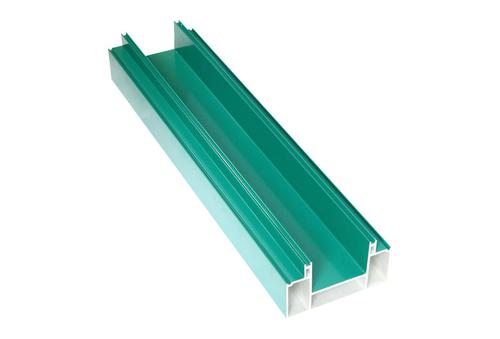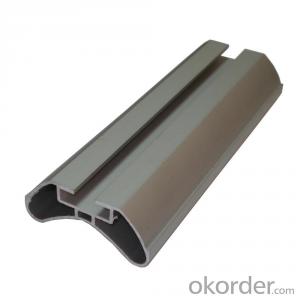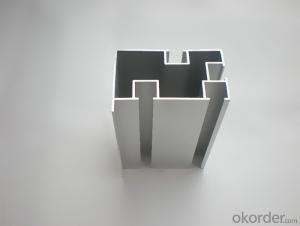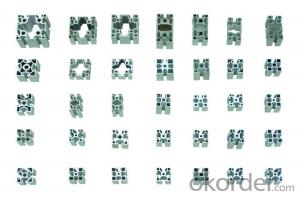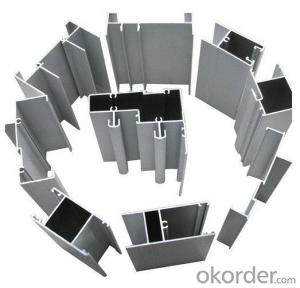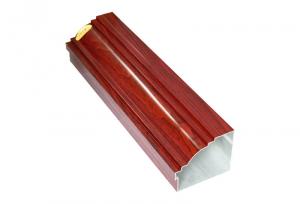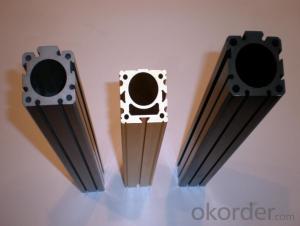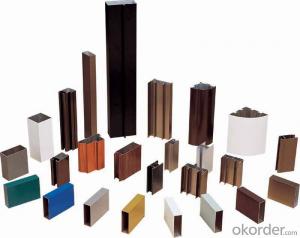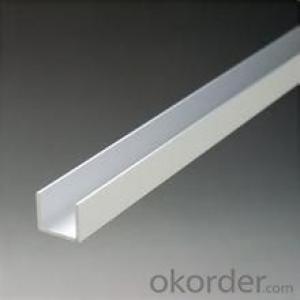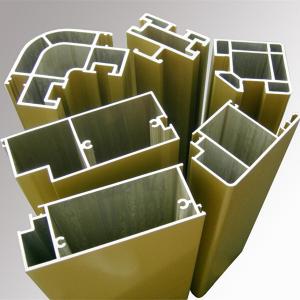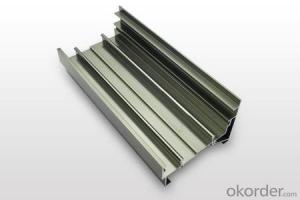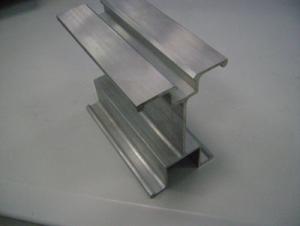Powder Coated T-Slot Aluminum Extrusion Profiles
- Loading Port:
- China Main Port
- Payment Terms:
- TT OR LC
- Min Order Qty:
- -
- Supply Capability:
- -
OKorder Service Pledge
OKorder Financial Service
You Might Also Like
POWDER COATED ALUMINUM PROFILE
Industrial aluminium profile
1)Material : 6063 6061 6060 and different aluminium alloy
2)Status:T4 T5 T6 or other special status
3)Surface treatment: mill finish, anodized sliver ,anodized bronze, anodized champagne, anodized black pearl, various power coating color, electrostatic sliver, electrostatic champagne, electrostatic golden, electrostatic titanium , machine polish sliver, machine polish bronze, wooden grain color, and Fluorocarbon spraying.
4)Annual capacity : 120000TON
5)Quality : China Nation Standard GB/T 5237 2008 (advanced class)
6)Use: can be widely using aluminium window, door, curtain wall, hand railing , normal aluminium profile, decorative and industrial aluminium profile
7)Advantage: Famous Brand reasonable&market price, soonest delivery and good after sale- service
8)Type of package:protection foam+heat contracted plastic film. / wooden packing / Metal pallet or depand on clientspecial requirement.
9)Payment term:T/T:30% of total value as deposite should paid by T/T within 3 days when confirmation ,and the remaining sum should be paid by T/T before delivery.L/C: 100% at sight
10)Delivery Day: 15-30days
11)Honor : CHINA FAMOUS TRADEMARK, CHINA TOP BRAND, ISO9001-2000, CHINA SQUARE&ROUND COMMITTEE DNV
- Q: How much is the 5000 ton aluminum profile extrusion machine? What section can I have?
- I've been in the aluminum industry for several years and haven't seen 5000 tons
- Q: Are aluminum profiles suitable for curtain walls and facades?
- Yes, aluminum profiles are highly suitable for curtain walls and facades. Aluminum is a lightweight, durable, and versatile material that offers numerous benefits for these applications. Firstly, aluminum profiles provide excellent strength and structural integrity, making them capable of withstanding various weather conditions, including wind loads and seismic forces. This makes them ideal for curtain walls and facades, where structural stability is essential. Additionally, aluminum is highly corrosion-resistant, which is crucial for exterior applications. It does not rust or deteriorate when exposed to moisture or other environmental factors, ensuring the longevity and durability of the curtain walls and facades. Furthermore, aluminum profiles offer design flexibility. They can be easily extruded into various shapes and sizes, allowing for the creation of unique and visually appealing curtain wall systems and facades. Aluminum also has a high strength-to-weight ratio, enabling the construction of large and expansive glazed areas while minimizing the overall weight of the structure. Aluminum profiles are also easy to install and maintain. They can be prefabricated and assembled off-site, reducing on-site construction time and costs. Additionally, aluminum requires minimal maintenance, typically only requiring occasional cleaning to maintain its appearance and functionality. Moreover, aluminum is a sustainable material. It is fully recyclable, meaning that it can be reused and repurposed at the end of its lifecycle, reducing waste and environmental impact. This aligns with the growing demand for eco-friendly and sustainable building practices. In conclusion, aluminum profiles are highly suitable for curtain walls and facades due to their strength, durability, corrosion resistance, design flexibility, ease of installation and maintenance, as well as their sustainability. They offer numerous advantages that make them a popular choice for architects, engineers, and building owners in these applications.
- Q: Can aluminum profiles be an alternative to steel or other materials?
- Many applications can consider aluminum profiles as a viable alternative to steel or other materials. Aluminum profiles possess several advantages over steel, including their lightweight nature, corrosion resistance, and durability. The low weight of aluminum profiles is a key benefit. Aluminum is approximately one-third the weight of steel, making it ideal for weight reduction purposes. Its lightweight property also makes it easier to handle, transport, and install, which ultimately reduces costs and labor requirements. Furthermore, aluminum profiles exhibit excellent corrosion resistance, especially when compared to steel. When exposed to air, aluminum naturally forms a protective oxide layer that prevents further oxidation and corrosion. This makes aluminum profiles suitable for industries such as construction, automotive, aerospace, and marine, where exposure to moisture, saltwater, or harsh weather conditions is common. Another advantage of aluminum profiles is their high strength-to-weight ratio. Aluminum alloys can be engineered to provide exceptional strength while still being lightweight. This makes them an excellent choice for structural applications that require both strength and weight reduction. In addition, aluminum profiles are highly durable and can withstand extreme temperatures. Aluminum has a melting point of 660 degrees Celsius, which is significantly higher than most other non-ferrous metals. This makes it suitable for applications where exposure to high temperatures or thermal stress is expected. Aluminum profiles are also easily fabricated, allowing for complex shapes and designs. They can be extruded, machined, welded, or formed into various configurations to meet specific requirements. This flexibility in manufacturing processes makes aluminum profiles a versatile material choice. However, it is important to note that aluminum profiles may not be suitable for all applications. Steel still offers superior strength and rigidity, making it more appropriate for heavy-duty applications or areas requiring high impact resistance. Additionally, the cost of aluminum profiles can be higher compared to steel, depending on the specific alloy and manufacturing processes involved. In conclusion, aluminum profiles can be considered as a viable alternative to steel or other materials in many applications. Their lightweight nature, corrosion resistance, high strength-to-weight ratio, durability, and ease of fabrication make them an attractive choice for various industries. However, it is crucial to carefully consider the specific requirements of each application before deciding on the most suitable material.
- Q: I am a mold professional, in school are mainly plastic mold and stamping die, but I am now in an aluminum extrusion die master apprentice. Draw pictures every day and walk around the workshop. But I have never met any related knowledge before, and I don't know where to start. I don't know what to do. Sometimes even want to give up, but not reconciled. I hope you can give me some advice. Thank you very much!!!
- 1, to let them die factory processing, mold design they figure, their wages are high, so I want to learn, do not know where to start, buy a book, the mold design of aluminum extrusion, want to learn to know the properties of extrusion machine, structure;2, according to the experience, to a step by step to produce aluminum profile extrusion die to meet the size requirements, first of all to ensure the uniformity of metal flow and extrusion out of the heart often Youao phenomenon, cause the surface subsidence, the flatness is not standard, through a lot of practice conclusion.
- Q: Can aluminum profiles be utilized for creating distinctive architectural designs, and if yes, what are the ways to achieve this?
- <p>Yes, aluminum profiles can be used to create unique architectural designs. They are favored for their strength, light weight, and corrosion resistance, which allow for innovative and sustainable building solutions. Architects can use aluminum profiles in various ways: as structural components in curtain walls, as decorative elements in facades, or as supports in roof structures. The profiles can be custom-cut and shaped to fit specific design requirements, and they can be combined with glass or other materials to create a harmonious blend of aesthetics and functionality. Additionally, aluminum's recyclability and low maintenance make it an environmentally friendly choice for architectural projects.</p>
- Q: This question asks for a list of various materials that are used in the production of aluminum profiles.
- <p>Aluminum profiles are primarily made from aluminum alloys, which are composed of aluminum combined with other elements to enhance their properties. Common materials used include 6063 aluminum alloy, known for its excellent extrudability and weldability, making it ideal for a wide range of applications. 6061 aluminum alloy is also used for its high strength and good corrosion resistance, suitable for structural components. Other alloys such as 6082 and 7075 are utilized for their superior strength-to-weight ratios, often found in aerospace and automotive industries. Additionally, aluminum profiles may incorporate materials like magnesium, silicon, copper, and manganese to achieve specific mechanical properties or corrosion resistance tailored to particular applications.</p>
- Q: Are aluminum profiles suitable for furniture applications?
- Yes, aluminum profiles are suitable for furniture applications. Aluminum is a versatile and lightweight material that offers several advantages for furniture design and construction. Firstly, aluminum profiles provide excellent strength and durability, making them ideal for furniture that needs to withstand regular use and weight-bearing. They are resistant to corrosion, which means they can be used both indoors and outdoors without the risk of rusting or deteriorating over time. Additionally, aluminum profiles offer flexibility in design. They can be easily shaped and formed into various shapes and sizes, allowing for creative and innovative furniture designs. Aluminum profiles can also be extruded into different profiles and sections, enabling customization and adaptability to different furniture styles and requirements. Furthermore, aluminum is a sustainable material that can be recycled repeatedly without losing its properties. This makes it an environmentally friendly choice for furniture applications. Overall, aluminum profiles provide a combination of strength, durability, versatility, and sustainability, making them a suitable choice for various furniture applications.
- Q: Can aluminum profiles be used in modular exhibition system manufacturing?
- Certainly! In the realm of manufacturing modular exhibition systems, aluminum profiles prove to be of great utility. Renowned for their lightweight and durable attributes, aluminum profiles become an ideal choice for the construction of modular exhibition systems. Their effortless handling and assembly facilitate swift and efficient installation and dismantling of exhibition booths. Moreover, the flexibility to customize and reconfigure aluminum profiles to cater to specific design preferences further enhances their versatility in the manufacturing of modular exhibition systems.
- Q: Can aluminum profiles be an alternative to steel in certain applications?
- Certainly, aluminum profiles have the potential to serve as a feasible substitute for steel in specific applications. Aluminum profiles possess numerous advantages over steel, rendering them suitable for particular use cases. Primarily, aluminum profiles exhibit a significantly lighter weight compared to steel, which proves advantageous in industries where weight reduction is crucial, such as aerospace or automotive applications. The reduced weight of aluminum profiles also facilitates their handling and installation in diverse construction projects. Secondarily, aluminum profiles boast exceptional corrosion resistance properties. Unlike steel, which is susceptible to rust and corrosion, aluminum naturally develops a protective oxide layer on its surface, providing long-term safeguarding against environmental elements. This renders aluminum profiles a preferred option in outdoor applications or environments exposed to high humidity or chemicals. Additionally, aluminum profiles possess a higher strength-to-weight ratio in comparison to steel. Although steel generally exhibits greater strength, aluminum profiles can still offer adequate strength for numerous applications while remaining significantly lighter. This attribute renders aluminum profiles suitable for structures requiring substantial strength but necessitating a lightweight characteristic, such as building facades or bridges. Moreover, aluminum profiles possess superior thermal conductivity in relation to steel. This makes them an excellent choice for applications mandating efficient heat dissipation or thermal management, such as heatsinks or heat exchangers. To summarize, while steel maintains its status as the preferred choice in many applications due to its strength, aluminum profiles can serve as a viable alternative in specific scenarios. Their lightweight nature, corrosion resistance, high strength-to-weight ratio, and thermal conductivity render them ideal for particular industries and projects.
- Q: How do aluminum profiles perform in terms of UV resistance?
- Aluminum profiles generally offer good UV resistance. The natural oxide layer that forms on the surface of aluminum provides some level of protection against UV radiation. However, the performance of aluminum profiles in terms of UV resistance can vary depending on various factors such as the specific alloy used, the quality of surface treatment, and the environmental conditions they are exposed to. Alloys that contain higher amounts of copper, such as 6000 series aluminum, tend to have better UV resistance than pure aluminum or alloys with lower copper content. This is because copper enhances the natural oxide layer's ability to withstand UV radiation. In terms of surface treatment, aluminum profiles that undergo proper anodizing or powder coating processes tend to have improved UV resistance. Anodizing involves creating a thicker and more durable oxide layer on the surface of the aluminum, which enhances its ability to resist UV damage. Powder coating, on the other hand, involves applying a protective layer of polymer to the aluminum surface, which acts as a barrier against UV radiation. Environmental conditions can also affect the UV resistance of aluminum profiles. Intense sunlight, high temperatures, and exposure to pollutants or corrosive substances can accelerate the degradation of the oxide layer and reduce the overall UV resistance. Regular cleaning and maintenance can help prolong the lifespan and UV resistance of aluminum profiles. In summary, aluminum profiles generally offer good UV resistance due to the natural oxide layer on the surface. Factors such as alloy composition, surface treatment, and environmental conditions can influence their performance in terms of UV resistance. It is recommended to consult with manufacturers or suppliers to ensure that the specific aluminum profiles meet the required UV resistance for the intended application.
Send your message to us
Powder Coated T-Slot Aluminum Extrusion Profiles
- Loading Port:
- China Main Port
- Payment Terms:
- TT OR LC
- Min Order Qty:
- -
- Supply Capability:
- -
OKorder Service Pledge
OKorder Financial Service
Similar products
Hot products
Hot Searches
Related keywords
